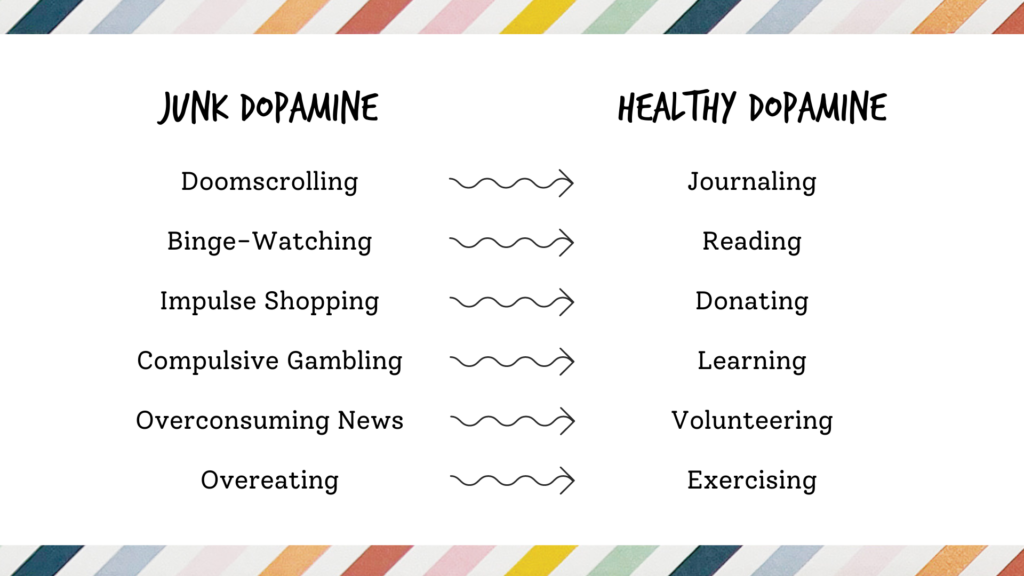Have you ever found yourself endlessly scrolling through social media, downing snacks without hunger, or binge-watching shows late into the night? I’m guilty of all of the above. These activities often give us quick hits of pleasure, but they leave us feeling hollow or guilty afterward. In this article, let’s explore the concept of “junk dopamine”—an unofficial term we’ll use to describe the quick yet fleeting boosts of dopamine from certain activities. We contrast this with more sustainable sources of this crucial neurotransmitter we’ll call “healthy dopamine”.
Understanding Dopamine
Dopamine is a neurotransmitter crucial for experiencing pleasure, motivation, and reward. While often associated with positive feelings, its role is much more complex. Dr. Anna Lembke, in Dopamine Nation, explores the double-edged nature of dopamine in our modern world of abundance. She highlights how easily accessible, high-dopamine activities can lead to cycles of intense pleasure followed by significant pain.
Lembke emphasizes that our pursuit of quick dopamine fixes, such as through doomscrolling social media or junk food, can leave us trapped in a cycle where the search for happiness actually leads to greater dissatisfaction and dependency. This phenomenon reflects the brain’s neurochemical response to overstimulation, making moderation and mindfulness critical in managing our dopamine-driven behaviors.
By understanding the delicate balance of dopamine, we can strive for healthier engagements that provide more sustainable satisfaction and contribute positively to our long-term well-being.
Junk Dopamine vs. Healthy Dopamine: Defining the Terms
While the terms “junk dopamine” and “healthy dopamine” are not scientifically recognized, they help us discuss how different activities impact our long-term happiness and health, often leading to either fleeting pleasure followed by dissatisfaction or more enduring fulfillment.
It’s important to note that activities labeled as “junk dopamine” may not be inherently bad but can become problematic if done excessively. Of course, activities labeled as “healthy dopamine” could become problematic in extreme situations. Moderation is key and individual experiences with these activities can vary. Being intentional with our time and attention is essential.
Junk Dopamine: This term, while informal, describes the dopamine release from activities that are easy but offer little long-term benefit. These are the quick fixes in our daily routines, such as mindlessly scrolling through social media or indulging in comfort foods excessively. They give a temporary boost but may lead to feelings of emptiness or dissatisfaction later.
Healthy Dopamine: This refers to the release of dopamine from engaging in activities that require more effort but offer greater rewards. Activities like exercising, learning a new skill, or connecting with others not only enhance our mood immediately. They also promote our long-term happiness and personal growth.

With a clear understanding of how “junk dopamine” and “healthy dopamine” influence our lives, let’s explore how we can intentionally shift our habits toward more enriching activities.
Practical Tips for Making the Shift Using WOOP
There are lots of ways to improve our habits and mindsets, but let’s take a look at a practical, evidence-based method known as WOOP (Wish, Outcome, Obstacle, Plan). WOOP is a powerful mental strategy that involves visualizing and planning for our goals; it can be particularly effective in replacing less beneficial behaviors with actions that enhance dopamine in healthy ways.
Wish:
What do you want to achieve? This could be reducing the time spent on social media, eating healthier, or incorporating regular exercise into your routine. Be clear and specific about what you wish to change.
Outcome:
Imagine the best possible outcome from achieving your wish. How would you feel? What would change in your life? Visualizing the benefits can increase your intrinsic motivation to pursue this change.
Obstacle:
Identify the main obstacles that could prevent you from achieving your wish. This could be habits, environmental triggers, emotional states, or other personal challenges. Understanding these barriers is crucial for planning effectively.
Plan:
Develop an action plan using “if-then” statements. For each obstacle identified, plan a specific response. For example, if the obstacle is the habit of reaching for your phone first thing in the morning to check social media, your plan might be, “If I wake up and want to check my phone, then I will first take a five-minute walk outside.”
By repeatedly practicing WOOP, we can strengthen our mental capacity to initiate and maintain the behaviors that lead to the release of healthy dopamine. This method not only supports the achievement of specific goals but also enhances overall mental resilience, making it easier to navigate the ups and downs of breaking free from “junk dopamine” activities.
As we continue to apply strategies like WOOP, we empower ourselves to make choices that align with our long-term health and happiness, rather than succumbing to the fleeting pleasures that lead to long-term dissatisfaction. This proactive approach is essential in cultivating a life that feels rewarding and fulfilling.
Next Steps
As we work towards healthier dopamine habits, it’s important to remember that this is a continuous journey we’re all on together. There’s always more to learn and room for growth. I encourage you to implement a strategy like the WOOP method in your daily routines to promote healthier choices that support your long-term health. As Anna Lembke insightfully remarks in Dopamine Nation, “The reason we’re all so miserable may be because we’re working so hard to avoid being miserable.” Let’s embrace healthier habits that genuinely enrich our lives rather than avoiding discomfort at the cost of our happiness.
With gratitude,
Lainie
Photo Credit: cottonbro studio


